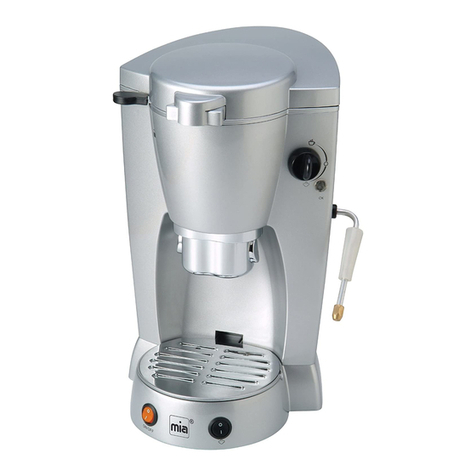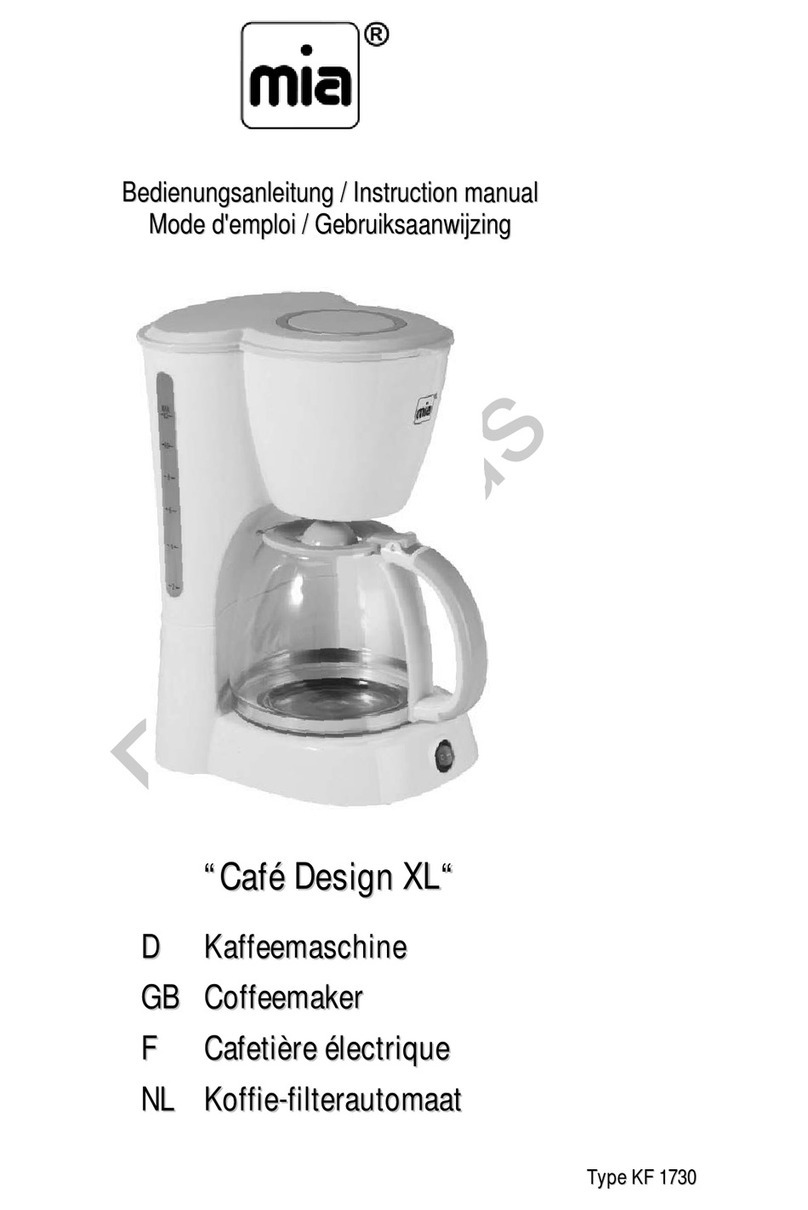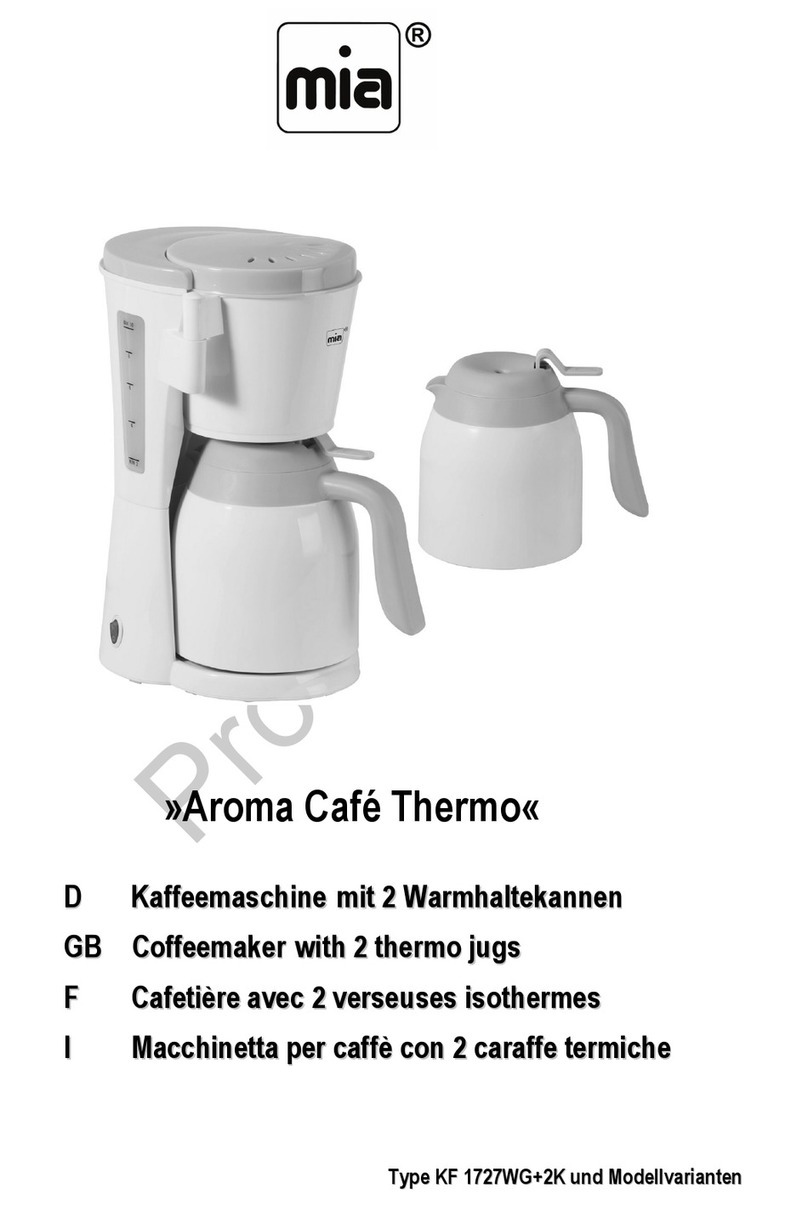
10
How to make Cappuccino
Cappuccino is espresso topped with steamed frothed milk. Frothing milk for cappuccino takes practice.
Do not be discouraged if it is not perfect the first time. The milk should be half steamed and half frothed.
Use skimmed milk or UHT milk. The milk and pitcher should be cold. We also recommend a stainless
steel frothing pitcher (capacity ca. 35o ml and 13 cm high).
The first step is making cappuccino is to make espresso.
Fill a small stainless steel pitcher 1/3 to ½ with cold milk.
Make sure the espresso machine is turned on and that there is water in the water reservoir. Press
the steam Start/Stop button. The steam ready light will come on when the unit is ready to froth milk
the brew ready light will stay on.
To froth milk, place the steaming tube in the pitcher with milk. Hold the pitcher so that the end of the
steaming tube is slightly submerged in milk Turn the Steam/Froth Control Knob counter clockwise to
begin frothing. The steam ready light will go off while you are frothing milk. This is normal and you
may continue frothing. Use Caution: Steam emitted from the frothing arm is very HOT. As the milk
heats up, the frothing pitcher will become very HOT.
The specially designed frothing attachment requires very little effort to produce thick and frothy milk.
To steam milk place the steaming tube in the pitcher with milk. Hold the pitcher so that the end of the
steamer tube is submerged in milk close to the bottom of the pitcher. When you are finished frothing
and steaming, turn the steam Control Knob clockwise until it stops. Do not over tighten. Press the
steam start/stop button to complete the process.
When the Steam Control Knob is closed, you will notice the machine release some steam.
This is the machine releasing the pressure it has generated during the steaming process and is
normal.
IMPORTANT
Clean the steam nozzle and frothing attachment immediately after each use. Fill the pitcher halfway with
water and run the steaming feature again for about 20 seconds. This will clean out the inside of the
steaming tube. Use a damp cloth to wipe off the exterior of the steaming tube and frother attachment.
You may want to rinse the frother attachment with warm, soapy water. If the end of the steam tube
becomes blocked with dry milk, use a sewing needle to clean out the small hole.
Attention!
After using the steaming feature of your machine, the heating system is at its highest temperature. If you
wish to prepare more espresso immediately after steaming milk, the heating system should be cooled
down to keep from “burning” your espresso. When the steam ready indicator light goes off, your machine
is now ready to brew espresso at the perfect temperature.
C
Cl
le
ea
an
ni
in
ng
ga
an
nd
dm
ma
ai
in
nt
te
en
na
an
nc
ce
e
When you have finished brewing espresso and steaming milk, turn the unit off, unplug the power cord
and let it cool down. It is not recommended to put the filter holder in the dishwasher.
The filter handle and the filter should be cleaned each time you brew espresso. Remove filter handle by
turning the handle from the middle to the left. The filter handle will release down from its locked position.
Use caution as the filter may still contain hot water floating on top of the coffee grounds. Knock the used
coffee grounds out wile holding the filter in place by holding the thumb guard lock firmly against the filter
cup. Rinse the filter cup and the filter holder out thoroughly with water.
If you are not going to use the machine again for some time, do not reinsert the filter holder on the brew
head; this will lengthen the service life of the filter seal.
Remove the water reservoir and empty out any remaining water. Do not wash the water Reservoir in the
dishwasher. Remove the Drip Tray and Overflow Grind from the machine and rinse with warm, soapy
water. Do not wash these parts in the dishwasher
Cleaning the brew head:

































